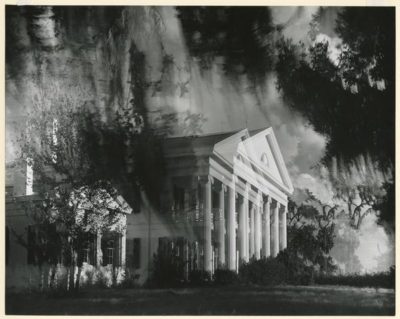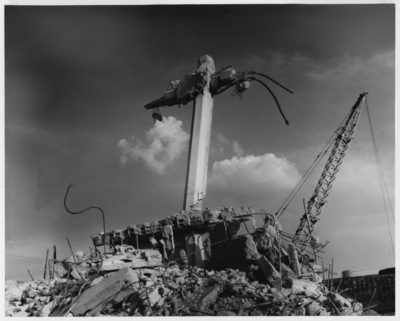Editor's Note
For previous entries in this series on cosmopolitan Christianity in early America, please see: The Christian and the Cosmos; The Puritan’s Grand Tour; The Preacher and the Pope; The Best of Both Worlds, 1853; From Sunny Memories to Oldtown Folks.

Clarence John Laughlin, “The Waters of Memory,” 1962. (The Historic New Orleans Collection, Louisiana Digital Library)
He never went to Rome, but Rome certainly heard of him. Orestes Augustus Brownson weathered several marathon conversions in his well-traveled life, resting in Catholicism. From a young age, the Stockbridge, Vt., native battled through religious ideas, testing them at every turn. A firm believer that “the laboring classes” were the true stewards of America’s soul, Brownson deployed European philosophy to reshape options for faith. But, unlike his contemporaries Horace Bushnell and Harriet Beecher Stowe, Brownson (1803-1876) skipped over glossy travel guides and vignettes of Vatican art. Rather, as editor of the Boston Quarterly Review, Brownson used his lay pulpit to search for faith through doubt. He stood alongside a generation of seekers who let the seams of inner struggle hang loose for all to see. The essayist drafted a new cosmopolitan Catholicism for the growing community of worshippers who ached for a louder public voice. Orestes Brownson’s feverish inquiry into his beliefs—and those of his audience—led him to question the heart of democracy.
One way to tackle Brownson’s mercurial shifts in thought is to consider what he read and heard. What fueled his mind? Reformers like William Ellery Channing
and Ralph Waldo Emerson shaped his early years of study. Brownson’s bookshelf bridged the Atlantic. When it came to designing his political theory, Brownson reached for the works of Immanuel Kant, Victor Cousin, and Henri de Saint-Simon. The American thinker struggled to weave their diverse ideas into a fresh vision of national progress. Another path into evaluating Brownson’s evolution, then, is to peer inside his religious imagination. There was a very real problem, Brownson thought, in rambling about the world of ideas without applying the lessons of it to a godly republic. Christian inquiry and American democracy must be joint forces for change, Brownson realized. “American statesmen have studied the constitutions of other states more than that of their own, and have succeeded in obscuring the American system in the minds of the people, and giving them in its place pure and simple democracy,” he wrote, “which is its false development or corruption.” As the Civil War consumed his country, Orestes Brownson turned to articulating the Christian patriot’s complaint.
In 1866 he published those lines in The American Republic: Its Constitution, Tendencies, and Destiny. His book was an effort to heal both North and South while syncing Catholic thought with the politics of Reconstruction. Here, he gives us a good tool to recast the intellectual history of an era lined with the haggard ideals of postbellum Christianity. The beginning sounds familiar. Brownson’s Americans were a covenanted people, unified by the ordeal of migration and selected for a special mission of nationhood. Like Bushnell, he favored an ideal of organic unity for the reunited states. Like Stowe, he was ready to wrestle with church history to prove it. There, the similarities end.
By promoting a Catholic framework for America’s future, Brownson embarked on an ambitious survey of natural rights and the organization and duties of the state. His goal was to acculturate Americans to a destiny of Catholicism. That meant rethinking much of the Christian patriotism that had long flavored national culture. One directive underpinned his every line of argument about how citizens should act: “If the Church has always asserted with the Apostle there is no power but from God—non est potestas nisi a Deo—she has always through her doctors maintained that it is a trust to be exercised for the public good, and is forfeited when persistently exercised in a contrary sense.” Keeping a democracy was based on holding territory, and not political grudges, Brownson added.

Clarence John Laughlin, “Crucified City, Number Three,” 1963. (The Historic New Orleans Collection, Louisiana Digital Library)
American Catholicism, in Brownson’s view, was worldly enough to salvage the country. A “return to the sounder principles of antiquity” marked this “transformation, which is rather going on than completed,” he wrote. To construct the fall and rise of The American Republic, Brownson leveraged the Catholic theology of communion. He modified ideas of Christian socialism percolating in European churches. And he held on tightly to exceptionalism. “Of all the states or colonies on this continent, the American Republic alone has a destiny, or the ability to add anything to the civilization of the race,” Brownson wrote, insisting that the “principles on which the state is founded have their origin and ground in the spiritual order—in the principles revealed or affirmed by religion—and are inseparable from them.” He recommended that Americans forgive all secessionists. Reconstruction, Brownson preached, symbolized a chance for resurrection. “There can be no question that the work to be done was that of restoration, not of creation,” he wrote. “No tribe should perish from Israel, no star be struck from the firmament of the Union.” Orestes A. Brownson’s cosmopolitan Christianity—most evident in his last conversion—gave Catholics a political voice in the recreation of American nationhood.
Like Stowe, Brownson wrote from a deep wellspring of New England church history. Here was a man who could not make reform as he intended, someone who felt lost within the liberal Protestant fold. That disillusionment shaded his outlook. “The Protestant party was, by its own avowal, a party of the past, and, if there are Protestants who are striving to be the party of the future, they succeed only by leaving their Protestantism behind, or by transforming it,” Brownson wrote a year after the Republic. His concerns extended farther, to a new landscape of factories and to the Catholic immigrants working inside. He worried that industrial capitalism had eroded morality. Progress and profit gouged all the good from business and behavior. So Brownson asked Americans to redouble their theological efforts. Transferring concepts of catholicity and communion, he argued, would smooth the roads of Reconstruction. With an eye on the horizon, Brownson predicted that while the “tendency of the last century was to individualism; that of the present is to socialism.” The world was shifting again. He moved with it, urging his fellow Catholics to match the tempo. In a past religious life, Brownson had issued an autobiographical novel, Charles Elwood (1840). There he reflected on the luminous limbo of a Christian confronting the cosmos: “I carried a whole world within me, infinitely superior to the world without me,” Brownson wrote, “and which should ere long replace it.”
*Thanks to The Historic New Orleans Collection and the Louisiana Digital Library, you can learn about artist Clarence John Laughlin (1905-1985) and experience more of his surrealist photography here.*

3 Thoughts on this Post
S-USIH Comment Policy
We ask that those who participate in the discussions generated in the Comments section do so with the same decorum as they would in any other academic setting or context. Since the USIH bloggers write under our real names, we would prefer that our commenters also identify themselves by their real name. As our primary goal is to stimulate and engage in fruitful and productive discussion, ad hominem attacks (personal or professional), unnecessary insults, and/or mean-spiritedness have no place in the USIH Blog’s Comments section. Therefore, we reserve the right to remove any comments that contain any of the above and/or are not intended to further the discussion of the topic of the post. We welcome suggestions for corrections to any of our posts. As the official blog of the Society of US Intellectual History, we hope to foster a diverse community of scholars and readers who engage with one another in discussions of US intellectual history, broadly understood.
Thanks for this post, Sara. It leaves me wondering what sort of policies Brownson advocated for Reconstruction and what place the freedmen held in his vision … especially that quote about restoration not creation.
I learned about Brownson while in graduate school, and have been fascinated ever since. I think this is the finest piece on him we’ve published here at the blog.
As a Catholic convert who has cared, and does care, deeply about American ideals, Brownson’s writings and thinking have resonated with me. I’ve always been troubled, however, by his characteristic 19th-century patriotism and nationalism. I felt after reading his prose that he was always trying to shove a round Catholic cosmopolitan peg into a square, parochial American hole. That theme in his work turned me off. Even so, I would’ve done more work on him, and perhaps even evolved as a 19th-century-focused Americanist and religio-intellectual historian, if any of my faculty members had pushed me harder, or even encouraged me, on the topic. – TL
Correction: I think this is the *only* piece focused solely on Brownson that we’ve published here. I’ve mentioned him several times before, as have others. But this is the first focused on him alone.